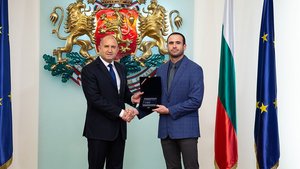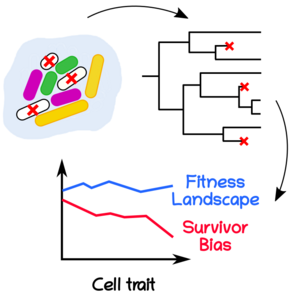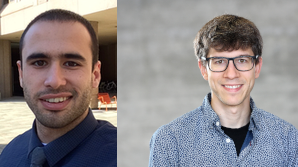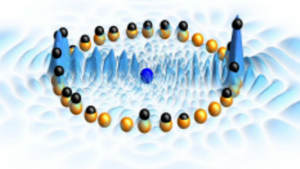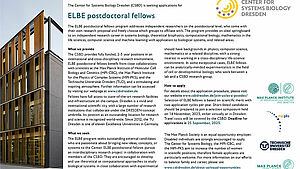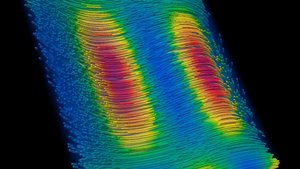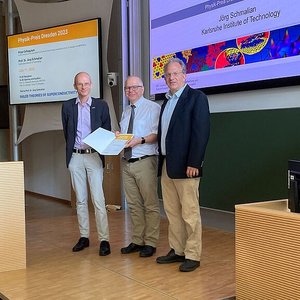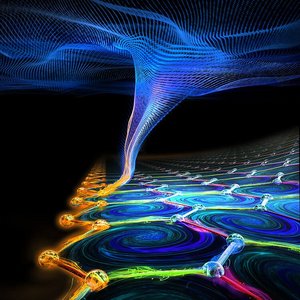
Highlights
Awards and Honors
Marin Bukov receives John Atanasoff Award
The John Atanasoff Award, named after the creator of the first electronic computer - the famous scholar of Bulgarian descent, John Atanasoff, was first awarded in 2003 in support of the personal achievements of young Bulgarian researchers working in the fields of informatics and information technology. Marin Bukov, group leader at MPI-PKS, is among this year's awardees ”for his outstanding contributions to the field of artificial intelligence applied to quantum technologies, and for his role in the development of efficient innovative research and education tools used worldwide”. Congratulations, Marin!
Read moreInstitute's News
Call for Distinguished PKS Postdoctoral Fellowship 2024 open!
Application deadline: 10 November 2023. Distinguished PKS postdoctoral fellows appear personally along with the departments and groups on the main research page of the institute and are expected to have at least one year of postdoctoral experience at an institution other than the one at which their PhD was awarded. Applications for this fellowship directly after completion of the PhD might be considered in exceptional cases.
Please click on the link- button to see the full advertisement!
Read morePublication Highlights
Cell Lineage Statistics with Incomplete Population Trees
Cell lineage statistics is a powerful tool for inferring cellular parameters, such as division rate, death rate, fitness landscape and selection. Yet, in practice such an analysis suffers from a basic problem: how should we treat incomplete lineages that do not survive until the end of the experiment? Examples of such lineages are found in experiments in which cells can die (antibiotic experiments, ...) and in experiments in which cells are diluted to maintain the population constant (microchannels, cytometers, ...).
Arthur Genthon of the Max Planck Institute for the Physics of Complex Systems, Takashi Nozoe (U. Tokyo, Japan), Luca Peliti (Santa Marinella Research Institute, Italy), and David Lacoste (Gulliver, Paris) have now developed a model-independent theoretical framework to address this issue.
They show how to quantify fitness landscape, survivor bias, and selection for arbitrary cell traits from cell lineage statistics in the presence of death, and they test this method using an experimental data set in which a cell population is exposed to a drug that kills a large fraction of the population. This analysis reveals that failing to properly account for dead lineages can lead to misleading fitness estimations. For simple trait dynamics, they prove and illustrate numerically that the fitness landscape and the survivor bias can in addition be used for the nonparametric estimation of the division and death rates, using only lineage histories. Their framework provides universal bounds on the population growth rate, and a fluctuation-response relation that quantifies the change in population growth rate due to the variability in death rate. Further, in the context of cell size control, they obtain generalizations of Powell's relation that link the distributions of generation times with the population growth rate, and they show that the survivor bias can sometimes conceal the adder property, namely the constant increment of volume between birth and division.
Arthur Genthon, Takashi Nozoe, Luca Peliti, and David Lacoste, PRX Life 1, 013014 (2023)
Read moreArthur Genthon, Takashi Nozoe, Luca Peliti, and David Lacoste, PRX Life 1, 013014 (2023)
Awards and Honors
Two ERC Starting Grants awarded to group leaders at MPI-PKS
The European Research Council (ERC) has announced early-career top researchers across Europe who will receive a starting grant. The prestigious grants enable the best young researchers in Europe to build their own teams and to conduct pioneering research across all disciplines. This year, two of these grants were awarded to research group leaders at the MPI-PKS: Marin Bukov for his proposal "Nonequilibrium Many Body Control of Quantum Simulators" and Ricard Alert for his proposal "The Spectrum of Fluctuations in Living Matter". Congratulations!!
Read morePublication Highlights
Anderson localization of a Rydberg electron
The hydrogen atom is one of the few exactly solvable quantum systems. Its well-known properties are shared by highly excited Rydberg atoms, albeit to such an exaggerated degree that their behavior is often wholly unexpected.
Scientists at the Max Planck Institute for the Physics of Complex Systems have now investigated a Rydberg atom perturbed by ground state atoms, exploiting hydrogen's infinite spectrum and high degeneracy to show that the Rydberg electron localizes in the same fashion as electrons in a disordered solid. This unexpected manifestation of Anderson localization is enabled by the existence of a well-defined thermodynamic limit of the single Rydberg electron as its principle quantum number and the number of ground state atoms increase in tandem. Myriad localization regimes can be realized as a function of the geometry of the system.
Matthew T. Eiles, Alexander Eisfeld, and Jan M. Rost, Phys. Rev. Research 5, 033032 (2023)
Read moreMatthew T. Eiles, Alexander Eisfeld, and Jan M. Rost, Phys. Rev. Research 5, 033032 (2023)
Institute's News
ELBE Postdoctoral Fellowships call is open!
Application deadline: 25 September 2023. The ELBE postdoctoral fellows program addresses independent researchers on the postdoctoral level, who come with their own research proposal and freely choose which groups to affiliate with. The program provides an ideal springboard to an independent research career in systems biology, theoretical biophysics, computational biology, mathematics in the life sciences, computer science and machine learning with application to biological systems, and related areas. Please click on the link- button for more info and application instructions!
Read morePublication Highlights
An artificial intelligence agent manipulates many interacting quantum bits of information
In recent years, quantum technologies have experienced significant growth, offering immense potential in various areas. Quantum computers are expected to revolutionise optimisation and search algorithms; quantum simulators help explore new quantum phases of matter; quantum sensors can achieve unparalleled precision in measurements, and quantum cryptography provides robust security for communication protocols. The advantage of these new technologies over their classical counterparts lies in quantum correlations (called by physicists quantum entanglement), and realises phenomena beyond the scope of classical physics.
However, the successful implementation of most quantum technologies relies heavily on the ability to manipulate the underlying quantum systems. This task is already challenging in classical dynamics, but quantum physics adds an extra layer of complexity. The issue arises from the difficulty in simulating quantum systems with many interacting qubits, as the memory requirements exceed the capabilities of even the best classical supercomputers.Physicists refer to this challenge as the "curse of dimensionality", rendering it infeasible to simulate the behavior of large quantum many-body systems using classical computers and devising optimal control strategies for them.
Addressing this problem, Friederike Metz (OIST and EPFL) and Marin Bukov (Max Planck Institute for the Physics of Complex Systems and Sofia University) introduced a new approach: they applied deep reinforcement learning (RL), a subfield of machine learning, to design an artificial intelligent agent capable of controlling quantum many-body systems effectively. To overcome the curse of dimensionality, they employed tensor networks–mathematical structures that allow for an approximate representation of large quantum states on classical computers. Leveraging tensor networks, Metz and Bukov developed a novel deep learning architecture that empowers RL agents to process and interpret quantum many-body states seamlessly.
The trained RL agent demonstrated remarkable performance in preparing ordered ground states in the quantum Ising chain, a fundamental model for studying quantum magnetism. This new framework surpassed the limitations of standard neural-network-only architectures, enabling the control of significantly larger systems while retaining the benefits of deep learning algorithms, such as generalizability and trainable robustness to noise. Notably, the RL agent exhibited the ability to find universal controls in few-qubit systems, learn to steer previously unseen many-qubit states optimally, and adapt control protocols in real-time when faced with stochastic perturbations in quantum dynamics. Additionally, the authors propose a way to map their RL framework to a hybrid quantum-classical algorithm that can be executed on noisy intermediate-scale quantum devices.
This research has profound implications, paving the way for applying deep RL to efficiently control large quantum systems–a crucial requirement for advancing modern quantum technologies. With these techniques, researchers expect to explore novel quantum phases, design complex molecules, achieve unprecedented measurement precision, and build secure networks using quantum communication, among other groundbreaking applications.
An earlier version of this text was improved using ChatGPT. The image accompanying the text was created with the assistance of DALL·E 2 using the prompt "A robot manipulating atoms in a quantum computer, Surrealism".
Friederike Metz and Marin Bukov, Nat. Mach. Intell. 5, 780 (2023)
Read moreHowever, the successful implementation of most quantum technologies relies heavily on the ability to manipulate the underlying quantum systems. This task is already challenging in classical dynamics, but quantum physics adds an extra layer of complexity. The issue arises from the difficulty in simulating quantum systems with many interacting qubits, as the memory requirements exceed the capabilities of even the best classical supercomputers.Physicists refer to this challenge as the "curse of dimensionality", rendering it infeasible to simulate the behavior of large quantum many-body systems using classical computers and devising optimal control strategies for them.
Addressing this problem, Friederike Metz (OIST and EPFL) and Marin Bukov (Max Planck Institute for the Physics of Complex Systems and Sofia University) introduced a new approach: they applied deep reinforcement learning (RL), a subfield of machine learning, to design an artificial intelligent agent capable of controlling quantum many-body systems effectively. To overcome the curse of dimensionality, they employed tensor networks–mathematical structures that allow for an approximate representation of large quantum states on classical computers. Leveraging tensor networks, Metz and Bukov developed a novel deep learning architecture that empowers RL agents to process and interpret quantum many-body states seamlessly.
The trained RL agent demonstrated remarkable performance in preparing ordered ground states in the quantum Ising chain, a fundamental model for studying quantum magnetism. This new framework surpassed the limitations of standard neural-network-only architectures, enabling the control of significantly larger systems while retaining the benefits of deep learning algorithms, such as generalizability and trainable robustness to noise. Notably, the RL agent exhibited the ability to find universal controls in few-qubit systems, learn to steer previously unseen many-qubit states optimally, and adapt control protocols in real-time when faced with stochastic perturbations in quantum dynamics. Additionally, the authors propose a way to map their RL framework to a hybrid quantum-classical algorithm that can be executed on noisy intermediate-scale quantum devices.
This research has profound implications, paving the way for applying deep RL to efficiently control large quantum systems–a crucial requirement for advancing modern quantum technologies. With these techniques, researchers expect to explore novel quantum phases, design complex molecules, achieve unprecedented measurement precision, and build secure networks using quantum communication, among other groundbreaking applications.
An earlier version of this text was improved using ChatGPT. The image accompanying the text was created with the assistance of DALL·E 2 using the prompt "A robot manipulating atoms in a quantum computer, Surrealism".
Friederike Metz and Marin Bukov, Nat. Mach. Intell. 5, 780 (2023)
Publication Highlights
Understanding 3D Active Fluids Through Mathematical Supercomputing
Active matter physics is a cornerstone theory to understand biological phenomena across multiple scales, ranging from cellular movement to tissue morphogenesis and the flocking behavior of animals. One such fascinating class of active matter are active fluids. These are densely packed, soft substances whose component parts can flow independently and operate by dissipating energy at the microscopic scale to perform directed motion. Although this offers a general framework that can be applied to practically all of biology, active fluids are incredibly challenging to understand in three dimensions due to increased mathematical and computational complexity. Given the technical obstacles and a lack of the necessary supercomputing scientific software for 3D investigations, only two-dimensional models of active fluids were investigated in the previous decade.
In a current study, Frank Jülicher, director at the Max Planck Institute of the Complex Systems, investigates, together with the research group of Ivo Sbalzarini, TU Dresden Professor in the Center for Systems Biology Dresden (CSBD), Research Group Leader at the Max Planck Institute of Molecular Cell Biology and Genetics (MPI-CBG), and Dean of the Faculty of Computer Science at the TU Dresden, how an active fluid behaves in a three-dimensional environment. Recent experiments that directly correspond to the three-dimensional world we live in, have observed that microtubules and kinesin motor protein mixtures can flow on their own in different directions, but a comprehensive theoretical model explaining these observations and how to control them was missing. Abhinav Singh, the first author of the study, explains: “Our most important discovery is that boundary conditions, which are frequently overlooked in ideal physical models, are crucial in the formation of instabilities in active matter. In simple terms, this means that the active material can latch onto and interact with the boundary or surface it is against, and then move in two ways: in the direction of alignment (in-plane) or perpendicular to the alignment of polymers (out-of-plane). Whether it is pulled or pushed by its internal motors, and the way molecules orient at the edges, dictate the movement. Interestingly, we discovered a unique 3D 'rippling' or 'wrinkling' effect that corresponds directly to the observed puzzling behavior of microtubules when they are under a stretching force created by motors called kinesins. These results were confirmed through rigorous mathematical analysis and unprecedented supercomputing codes of novel numerical techniques, marking a significant leap in our understanding of active biological processes.”
“These findings expand our understanding of the behavior of active matter and move us one step closer to unraveling the beautiful complexity of morphogenesis,” concludes Ivo Sbalzarini, who supervised the study. “Our findings and software contributions in OpenFPM will be instrumental for physicists, biologists, and materials scientists who are looking into the behavior of active fluids made up of living materials. This new understanding can enhance the manipulation and control of active fluids, paving the way for a range of applications, from microfluidic devices to drug delivery systems and novel material designs. However, further research is necessary to validate our findings in various real-world scenarios.”
(Highlight text by Katrin Boes, MPI-CBG)
Abhinav Singh, Quentin Vagne, Frank Jülicher, and Ivo F. Sbalzarini, Phys. Rev. Research 5, L022061 (2023)
Read moreIn a current study, Frank Jülicher, director at the Max Planck Institute of the Complex Systems, investigates, together with the research group of Ivo Sbalzarini, TU Dresden Professor in the Center for Systems Biology Dresden (CSBD), Research Group Leader at the Max Planck Institute of Molecular Cell Biology and Genetics (MPI-CBG), and Dean of the Faculty of Computer Science at the TU Dresden, how an active fluid behaves in a three-dimensional environment. Recent experiments that directly correspond to the three-dimensional world we live in, have observed that microtubules and kinesin motor protein mixtures can flow on their own in different directions, but a comprehensive theoretical model explaining these observations and how to control them was missing. Abhinav Singh, the first author of the study, explains: “Our most important discovery is that boundary conditions, which are frequently overlooked in ideal physical models, are crucial in the formation of instabilities in active matter. In simple terms, this means that the active material can latch onto and interact with the boundary or surface it is against, and then move in two ways: in the direction of alignment (in-plane) or perpendicular to the alignment of polymers (out-of-plane). Whether it is pulled or pushed by its internal motors, and the way molecules orient at the edges, dictate the movement. Interestingly, we discovered a unique 3D 'rippling' or 'wrinkling' effect that corresponds directly to the observed puzzling behavior of microtubules when they are under a stretching force created by motors called kinesins. These results were confirmed through rigorous mathematical analysis and unprecedented supercomputing codes of novel numerical techniques, marking a significant leap in our understanding of active biological processes.”
“These findings expand our understanding of the behavior of active matter and move us one step closer to unraveling the beautiful complexity of morphogenesis,” concludes Ivo Sbalzarini, who supervised the study. “Our findings and software contributions in OpenFPM will be instrumental for physicists, biologists, and materials scientists who are looking into the behavior of active fluids made up of living materials. This new understanding can enhance the manipulation and control of active fluids, paving the way for a range of applications, from microfluidic devices to drug delivery systems and novel material designs. However, further research is necessary to validate our findings in various real-world scenarios.”
(Highlight text by Katrin Boes, MPI-CBG)
Abhinav Singh, Quentin Vagne, Frank Jülicher, and Ivo F. Sbalzarini, Phys. Rev. Research 5, L022061 (2023)
Awards and Honors
"Physik-Preis Dresden 2023" awarded to Professor Jörg Schmalian
On July 11, 2023, Prof. Jörg Schmalian from the Karlsruhe Institute of Technology received the "Physik-Preis Dresden 2023" (Dresden Physics Prize), jointly awarded by the TU Dresden and the Max Planck Institute for the Physics of Complex Systems (MPI-PKS).
The "Physik-Preis Dresden" has been established, with a generous donation by Prof. Peter Fulde, to promote cooperation between the Max Planck Institute for the Physics of Complex Systems and the Faculty of Physics of TU Dresden. It is geared towards outstanding researchers whose research is of particular interest to scientists in Dresden. This year's recipient, Prof. Jörg Schmalian, fits this condition perfectly.
Jörg Schmalian studied physics in Leipzig and Merseburg and graduated from the Technische Hochschule Merseburg in 1990. The German reunification made it possible for him to obtain a doctorate in physics in 1993 from Freie Universität Berlin under the supervision of Karl Bennemann. He stayed at FU Berlin as a postdoc before joining the group of David Pines at the University of Illinois at Urbana-Champaign in 1997. In 1999, Jörg Schmalian moved back to Europe and became a fellow of St. Catherine's College at the University of Oxford. In the same year, he accepted an offer for a tenure-track faculty position at Iowa State University, in connection with a researcher position at Ames National Lab. Jörg Schmalian quickly moved up through the ranks to become full professor in 2007. In 2011, he moved to the Karlsruhe Institute of Technology as a professor. Currently, he is the Dean of the Faculty of Physics of KIT. Jörg Schmalian has been a visiting professor at Royal Holloway University, University of Paris Diderot, and Stanford University. He has received multiple honors, among them a fellowship of the American Physical Society and the 2022 John Bardeen Prize for Theory of Superconductivity.
Jörg Schmalian is an internationally highly visible theoretical physicist with a broad range of interests. He has published over 200 research papers with over 10.000 citations. Jörg Schmalian started to work on strongly correlated electrons and superconductivity during his doctoral studies, at that time with a focus on cuprate high-temperature superconductors. He later made significant contributions to superconductivity and other ordering phenomena in iron-based and organic compounds as well as more generally on the physics of coupled order parameters. It is characteristic for Jörg Schmalian's work that he has both established conceptual foundations and modeled and predicted specific phenomena, working close to experiments. Jörg Schmalian's papers on spin-fluctuation-mediated superconductivity and on nematic order have become standard references in these fields. Moreover, Jörg Schmalian's works on quantum criticality and transport in graphene have strongly advanced the hydrodynamics of electron liquids. They were essential for identifying graphene as a readily available system in which many aspects of hydrodynamical transport can be studied experimentally. Last but not least, Jörg Schmalian has made significant contributions to the field of disordered systems. He has worked on electronic glasses and disordered magnets as well as on novel superconducting phases in models with strong disorder.
Jörg Schmalian has multiple connections to Dresden, not only to theoretical physics groups at MPI-PKS and TUD. There is also strong overlap with experimental work done at IFW Dresden, at the Helmholtz-Zentrum Dresden-Rossendorf, and by Andrew Mackenzie's group at the Max Planck Institute for Chemical Physics of Solids. This is exemplified by a new paper on strontium ruthenate with Jörg Schmalian and Andrew Mackenzie as two of the authors.
The Physik-Preis Dresden for the year 2023 honors Jörg Schmalian as an outstanding theoretical condensed-matter physicist with strong connections to Dresden and will hopefully help to strengthen these connections further.
Read morePublication Highlights
Towards the realisation of chiral spin liquids and non-Abelian anyons in quantum simulators
Chiral spin liquids are one of the most fascinating phases of matter ever imagined by physicists. These exotic liquids exhibit quasi-particles known as non-Abelian anyons that are neither bosons nor fermions, the manipulation of which could allow for the realisation of a universal quantum computer. Despite intense efforts in condensed matter physics, discovering such a phase in Nature remains an outstanding challenge at the forefront of modern research.
From a theoretical point of view, chiral spin liquids emerge in a simple model that was imagined by Kitaev in 2006, and which allows revealing their properties using analytical tools. Remarkably, recent advances in the design of quantum simulators open a possible path for the first experimental realisation of the original Kitaev model, hence suggesting that chiral spin liquids (including their exotic quasi-particles) can be studied and manipulated in a highly-controlled experimental environment.
Recent work by an international collaboration involving BoYe Sun and Nathan Goldman (ULB, Brussels), Monika Aidelsburger (LMU, Munich), and Marin Bukov (Max Planck Institute for the Physics of Complex Systems and Sofia University) proposes a realistic implementation of the Kitaev model in quantum simulators. Based on a precise pulse sequence, their system is shown to host a chiral spin liquid with non-Abelian anyons. The authors describe practical methods to probe the striking properties of these exotic states. In particular, their methods unambiguously reveal the topological heat current that flows on the edge of the system: a hallmark signature of the non-Abelian anyons that emerge on the edge of chiral spin liquids.
This work paves the way for the quantum simulation of chiral spin liquids, offering an appealing alternative to their experimental investigation in quantum materials.
Bo-Ye Sun, Nathan Goldman, Monika Aidelsburger, and Marin Bukov, Phys. Rev. X Quantum 4, 020329 (2023).
Read moreFrom a theoretical point of view, chiral spin liquids emerge in a simple model that was imagined by Kitaev in 2006, and which allows revealing their properties using analytical tools. Remarkably, recent advances in the design of quantum simulators open a possible path for the first experimental realisation of the original Kitaev model, hence suggesting that chiral spin liquids (including their exotic quasi-particles) can be studied and manipulated in a highly-controlled experimental environment.
Recent work by an international collaboration involving BoYe Sun and Nathan Goldman (ULB, Brussels), Monika Aidelsburger (LMU, Munich), and Marin Bukov (Max Planck Institute for the Physics of Complex Systems and Sofia University) proposes a realistic implementation of the Kitaev model in quantum simulators. Based on a precise pulse sequence, their system is shown to host a chiral spin liquid with non-Abelian anyons. The authors describe practical methods to probe the striking properties of these exotic states. In particular, their methods unambiguously reveal the topological heat current that flows on the edge of the system: a hallmark signature of the non-Abelian anyons that emerge on the edge of chiral spin liquids.
This work paves the way for the quantum simulation of chiral spin liquids, offering an appealing alternative to their experimental investigation in quantum materials.
Bo-Ye Sun, Nathan Goldman, Monika Aidelsburger, and Marin Bukov, Phys. Rev. X Quantum 4, 020329 (2023).

